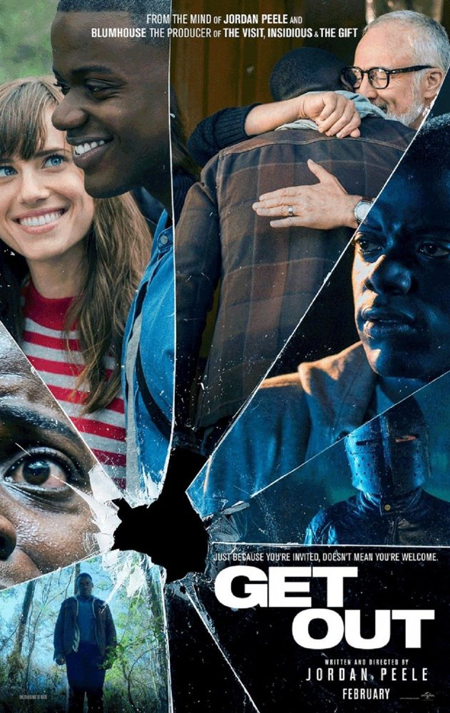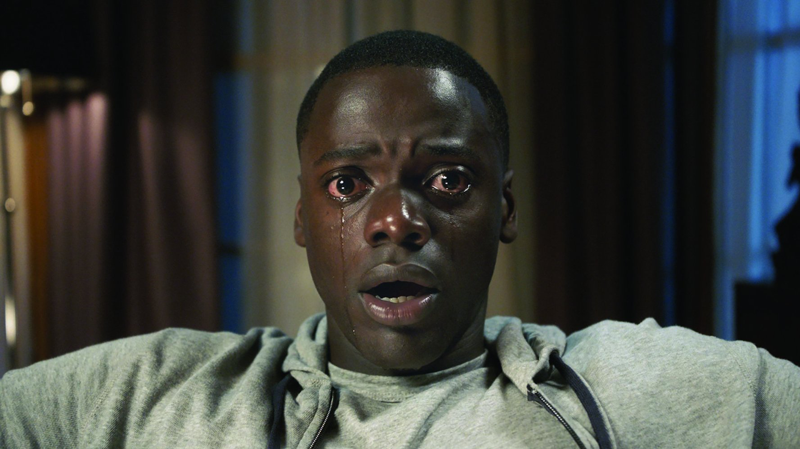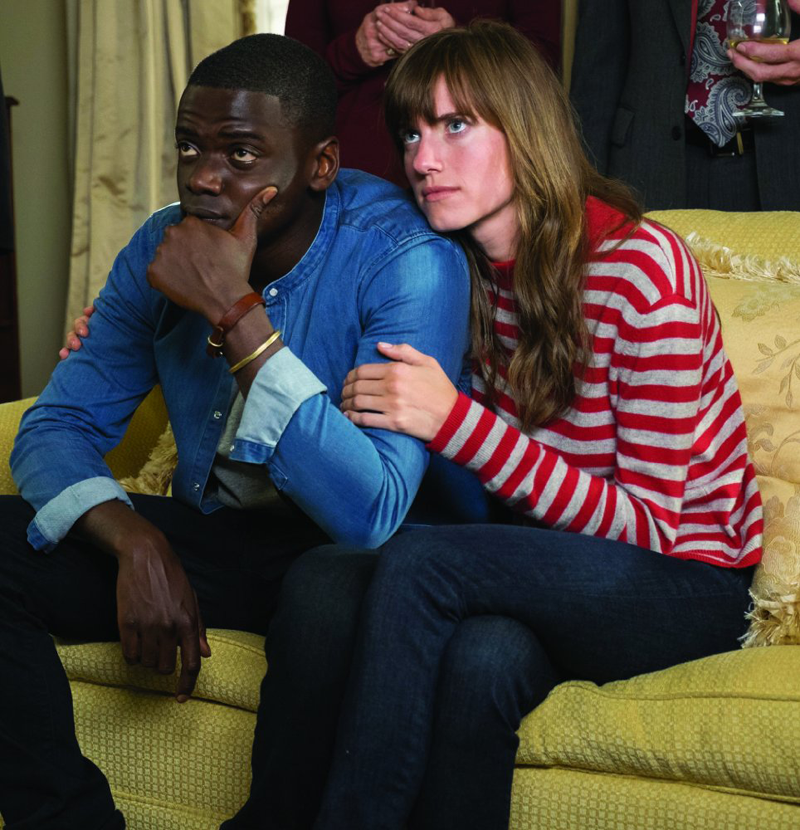by Jennifer Parker
May 07, 2017
 From the beginning of film history, movies have tried to tackle large social issues through a variety of genres. What makes a film remarkable is when the writer/director can marry different genres together and arrive at a work that not only has made nearly a 400 percent return on its original production costs in eight weeks but challenges the way we talk about complex social mores. What makes Get Out extraordinary is how Jordan Peele explores the subtleties of institutional racism through the genres of what on the surface are psychological horror and social satire but to me seems more a commentary on the dangers of a racially bifurcated society. The discomfort that Peele deftly makes his audience experience via Daniel Kaluuya's performance as Chris Washington is visceral. There are times in the film when we cringe with collective embar-rassment when well-meaning guests at an afternoon party ask Chris about “the African-American experience,” as if he is the spokesperson for all people of color in America.
From the beginning of film history, movies have tried to tackle large social issues through a variety of genres. What makes a film remarkable is when the writer/director can marry different genres together and arrive at a work that not only has made nearly a 400 percent return on its original production costs in eight weeks but challenges the way we talk about complex social mores. What makes Get Out extraordinary is how Jordan Peele explores the subtleties of institutional racism through the genres of what on the surface are psychological horror and social satire but to me seems more a commentary on the dangers of a racially bifurcated society. The discomfort that Peele deftly makes his audience experience via Daniel Kaluuya's performance as Chris Washington is visceral. There are times in the film when we cringe with collective embar-rassment when well-meaning guests at an afternoon party ask Chris about “the African-American experience,” as if he is the spokesperson for all people of color in America.
After seeing Get Out, I rewatched the 1975 film adaptation of Ira Levin’s The Stepford Wives and Stanley Kubrick’s 1972 adaptation of the Anthony Burgess novel, A Clockwork Orange.
The tropes of mental control from A Clockwork Orange and social satire from The Stepford Wives with the overarching theme of slavery thinly veiled as permanent indentured servitude ap-pear throughout Get Out. Peele asks the difficult question of complicity versus culpability. The entire Armitage clan and by extension their suburban social network is complicit where in Step-ford, only the men’s club render their wives soulless robots. Stanley Kubrick’s A Clockwork Orange debates the question of free will. If a person is robbed of free will, he is rendered a slave. Is Peele commenting that America could intern black men in the suburbs for the purpose of coopt-ing the physical life from his “superior body” with complete disregard to his soul?
There is something amiss in the Armitage household. The parents mean a little too well. The performances of Bradley Whitford and Catherine Keener as Drs. Dean and Missy Armitage are nuanced. As parents, they’re too good to be true. They are wealthy physicians who want their daughter, Rose (Allison Williams) to be happy and the only flaw they can find in her dark-skinned boyfriend is that he is a cigarette smoker. They just want to “fix” him. Their son Jeremy (Caleb Landry Jones) is the character we love to hate. He is an unapologetic arrogant white male. Peele is blunt in his writing and directing of Jeremy. Every scene that he is in, highlights his feel-ings about his sister dating a black man. His face is semi-lit to cast an aura of suspicion around him. The film gives us plenty of legitimate punching bags, we don’t need a douchebag.
To see Allison Williams portray Rose Armitage will make fans of Girls relieved that “Marnie” will have no problem finding a job. The girl can act.
Lil Rel Howery as Rod Williams manages the comedic trifecta. He is the unusual charac-ter who ironically functions as “the straight man,” stealing without dominating every scene that he is in. He is the lone voice of reason who no one takes seriously. Peele’s decision to make Rod a TSA agent was sapient otherwise his character may have teetered on the stereotype of the goofball friend. The joke is on us.

Daniel Kaluuya
Get Out is not a Black movie by a Black director about the African-American experience. It has just enough comedic relief to allow the audience a minute or two to take a breath to steel ourselves for what feels like a guided tour of institutional racism. The Armitage family has no idea how to comport themselves so they behave as if they are apologizing for having Archie Bunker as their Uncle. They feel like they have to prove to Chris that they aren’t racist all the while demonstrating prejudices that are practically in their DNA. It’s like you want to forgive them because they voted for Barack Obama but you know they still use vernacular like “my man” when speaking to a Black person to prove they know how Black people talk.
In the world of entertainment, one always has to be concerned with agency. Anyone who has seen I Am Not Your Negro the Cinéma vérité documentary about James Baldwin’s unfinished novel knows that the word “Negro” is a construct.1 Baldwin said that as long as we keep allow-ing ourselves to differentiate each other by the color of our skin that our society is broken. Peele has a white wife, Chelsea Peretti, and a white mother, Lucinda Williams, giving him agency to explore the complexities in an interracial relationship in a society that wants to believe it is post racial yet has proven itself not to be.
I wanted to understand more about some of the issues that Peele raises in Get Out so I contacted the one interracial couple that I know in New York. Full disclosure: I know Keisha Zollar because she was one of my improv teachers at the Upright Citizens Brigade Theater.
Keisha Zollar is a comedienne and a writer. She also says she’s “a crude and earthy black woman who loves politics and fart jokes.” What Keisha has a hard time telling you is that she has appeared in Orange Is the New Black and is currently a recurring character on the new HBO show, Divorce, starring Sarah Jessica Parker and Thomas Haden Church.2 Keisha has what she calls “slave-black” skin. It is flawless. She has doe-like brown eyes, cheekbones a super-model would kill for and super funky hair. Keisha Zollar is beautiful. She is married to comedian, writer, Andrew Kilmer who happens to be white. When asked about slavery as a metaphor re-garding institutional racism, Andrew said, “…I think the film created a great allegory for slavery fit into a more modern context. I also think where the film really succeeded was highlighting how modern racism manifests itself mapped onto a slavery allegory. In doing so it really drives home how slavery and modern day racism are inexorably linked.” Andrew has a grim read on cultural assumption in the film, “Black people's bodies were literally appropriated for the benefit of white people.” Keisha said, “It's funny because I thought the movie went deeper into appro-priation. The desire to be a Black body without context felt like more than just stealing black culture.”
If 4.3 percent of the Directors Guild of America membership are African American then there aren’t enough African American filmmakers working in Hollywood.3 African Americans make up 12 percent of the population in the United States yet represent 15 percent of the movie ticket sales for top grossing films. I asked Keisha and Andrew what they want to see more of in films. Keisha said, “Just more point of view! I've had friends criticize the film on the portrayal of Black women. Where are stories from Black women's perspectives? And can those be green-lit sooner rather than later. It's hard to tell a story and not bring some aspect of yourself so if you green light more stories from POC you will get stories that subtly and not so subtly tackle race. The easiest way to see better movie making is to let more underrepresented voices be seen as valid even when the content pushes your values.” Andrew had a different response. “There is a mindset in films (and American society at large) that racism either exists under a hood or while wearing an armband. When a person or character is racist it's overt and celebrated. I think this is such a twentieth century idea, and modern racism isn't always so unmistakable. This film was great at demonstrating how modern racism manifests itself, and that most racist actions don't come from self described supremacist, but pretty much from anyone in more subtle forms. I'm a big believer in diversity and really hope the industry's recent attempts aren't a fad or lip-service.”

Daniel Kaluuya and Allison Williams
If you could be guaranteed nearly a 400 percent return on an investment in approximately eight weeks, you would wonder why you hadn’t invested earlier. For a film with a modest pro-duction budget of $4.5 million and box office gross receipts in excess of $182 million dollars, Get Out has transcended marketing expectations. For a movie that didn’t cost very much to make, it has provoked people to think about their deeper feelings about race.
Without the aid of Google, I can name only six African American Directors and no, Spike Jonze is not Black. It is a mistake to believe that Get Out is a film by a person of color for people of color. It isn’t. Nor is it a film intended to shame white people. It is meant to be pro-vocative.
When psychological horror works in a film it is because we imagine that we see something relat-able in one of the characters. It doesn’t have to be an admirable quality that resonates. It just has to be a small trait that we can ascribe to ourselves. Who among us hasn’t crossed the street when we are walking alone at night when we see a Black man? If the answer is “not me,” then chances are you are Black.
1 Haitian born Raoul Peck is a member of the Directors Guild of America. He directed I Am Not Your Negro.
2 https://www.hbo.com/divorce/cast-and-crew/index.html
3 https://www.dga.org/The-Guild/Diversity/Diversity-FAQ.aspx It is important to note that 4.3% is the directorial team. The percentage of actual African-American Directors in the Guild is 3.6%.
From Russia, With Love A review of SCREENS: A Project About “Community”
The Inner Strength of Joan Didion
Basquiat—The Unanswerable Answer to the Art World
May It Last: A Portrait of the Avett Brothers
Move Over Hogwarts—The Practical Magic Is at Headfort
The Dog Days of Summer—Two Ways to Beat the Heat
The Mistress, the Publisher, His Son & His Mother
Santoalla-- the Spaces Between
Reading Arthur Miller in Tehran, The Salesman
Killing the ISIS Propaganda Machine, City of Ghosts
Bewitched, Bothered and Beguiled, The Beguiled– A Film Review
A Spoonful of Sugar-- Not Saccharine The Big Sick: A Film Review
Fiona and the Tramp, Lost in Paris- a review
Movie Review: Beatriz at Dinner
Cameraperson, dir. Kristen Johnson: stories from behind the camera lens
SELFISH, Review by Heather Zises
Winter on Fire: Ukraine’s Fight For Freedom, dir. Evgeniy Afineevsky
Strange Days directed by Kathryn Bigelow (1995)
World of Tomorrow and the Quit-Bang Language of the Future
Quintet, Directed by Robert Altman, 1979
Classic Movie Short Review: Croupier (1998)
